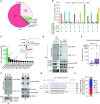Regulation of La/SSB-dependent viral gene expression by pre-tRNA 3' trailer-derived tRNA fragments
- PMID: 31504775
- PMCID: PMC6765225
- DOI: 10.1093/nar/gkz732
Regulation of La/SSB-dependent viral gene expression by pre-tRNA 3' trailer-derived tRNA fragments
Abstract
tRNA-derived RNA fragments (tRFs) have emerged as a new class of functional RNAs implicated in cancer, metabolic and neurological disorders, and viral infection. Yet our understanding of their biogenesis and functions remains limited. In the present study, through analysis of small RNA profile we have identified a distinct set of tRFs derived from pre-tRNA 3' trailers in the hepatocellular carcinoma cell line Huh7. Among those tRFs, tRF_U3_1, which is a 19-nucleotide-long chr10.tRNA2-Ser(TGA)-derived trailer, was expressed most abundantly in both Huh7 and cancerous liver tissues, being present primarily in the cytoplasm. We show that genetic loss of tRF_U3_1 does not affect cell growth and it is not involved in Ago2-mediated gene silencing. Using La/SSB knockout Huh7 cell lines, we demonstrate that this nuclear-cytoplasmic shuttling protein directly binds to the 3' U-tail of tRF_U3_1 and other abundantly expressed trailers and plays a critical role in their stable cytoplasmic accumulation. The pre-tRNA trailer-derived tRFs capable of sequestering the limiting amounts of La/SSB in the cytoplasm rendered cells resistant to various RNA viruses, which usurp La/SSB with RNA chaperone activity for their gene expression. Collectively, our results establish the trailer-derived tRF-La/SSB interface, regulating viral gene expression.
© The Author(s) 2019. Published by Oxford University Press on behalf of Nucleic Acids Research.
Figures






Similar articles
-
A novel class of small RNAs: tRNA-derived RNA fragments (tRFs).Genes Dev. 2009 Nov 15;23(22):2639-49. doi: 10.1101/gad.1837609. Genes Dev. 2009. PMID: 19933153 Free PMC article.
-
tRNA-derived fragments: Mechanisms underlying their regulation of gene expression and potential applications as therapeutic targets in cancers and virus infections.Theranostics. 2021 Jan 1;11(1):461-469. doi: 10.7150/thno.51963. eCollection 2021. Theranostics. 2021. PMID: 33391486 Free PMC article. Review.
-
Precise mapping and dynamics of tRNA-derived fragments (tRFs) in the development of Triops cancriformis (tadpole shrimp).BMC Genet. 2015 Jul 14;16:83. doi: 10.1186/s12863-015-0245-5. BMC Genet. 2015. PMID: 26168920 Free PMC article.
-
tRNA-derived fragments and tRNA halves: The new players in cancers.Cancer Lett. 2019 Jun 28;452:31-37. doi: 10.1016/j.canlet.2019.03.012. Epub 2019 Mar 21. Cancer Lett. 2019. PMID: 30905816
-
Biochemical properties and progress in cancers of tRNA-derived fragments.J Cell Biochem. 2020 Mar;121(3):2058-2063. doi: 10.1002/jcb.29492. Epub 2019 Oct 31. J Cell Biochem. 2020. PMID: 31674076 Review.
Cited by
-
tRNA-derived small RNAs in digestive tract diseases: Progress and perspectives.Genes Dis. 2024 May 13;12(3):101326. doi: 10.1016/j.gendis.2024.101326. eCollection 2025 May. Genes Dis. 2024. PMID: 40083327 Free PMC article. Review.
-
Roles and regulation of tRNA-derived small RNAs in animals.Nat Rev Mol Cell Biol. 2024 May;25(5):359-378. doi: 10.1038/s41580-023-00690-z. Epub 2024 Jan 5. Nat Rev Mol Cell Biol. 2024. PMID: 38182846 Review.
-
Mammalian antiviral systems directed by small RNA.PLoS Pathog. 2021 Dec 16;17(12):e1010091. doi: 10.1371/journal.ppat.1010091. eCollection 2021 Dec. PLoS Pathog. 2021. PMID: 34914813 Free PMC article. Review.
-
WITHDRAWN: Gammaherpesvirus infection alters transfer RNA splicing and triggers tRNA cleavage.bioRxiv [Preprint]. 2025 Jan 10:2024.02.16.580780. doi: 10.1101/2024.02.16.580780. bioRxiv. 2025. PMID: 38405876 Free PMC article. Preprint.
-
"Transfer" of power: The intersection of DNA virus infection and tRNA biology.Semin Cell Dev Biol. 2023 Sep 15;146:31-39. doi: 10.1016/j.semcdb.2023.01.011. Epub 2023 Jan 20. Semin Cell Dev Biol. 2023. PMID: 36682929 Free PMC article. Review.
References
-
- Borek E., Baliga B.S., Gehrke C.W., Kuo C.W., Belman S., Troll W., Waalkes T.P.. High turnover rate of transfer RNA in tumor tissue. Cancer Res. 1977; 37:3362–3366. - PubMed
-
- Speer J., Gehrke C.W., Kuo K.C., Waalkes T.P., Borek E.. tRNA breakdown products as markers for cancer. Cancer. 1979; 44:2120–2123. - PubMed
Publication types
MeSH terms
Substances
LinkOut - more resources
Full Text Sources

